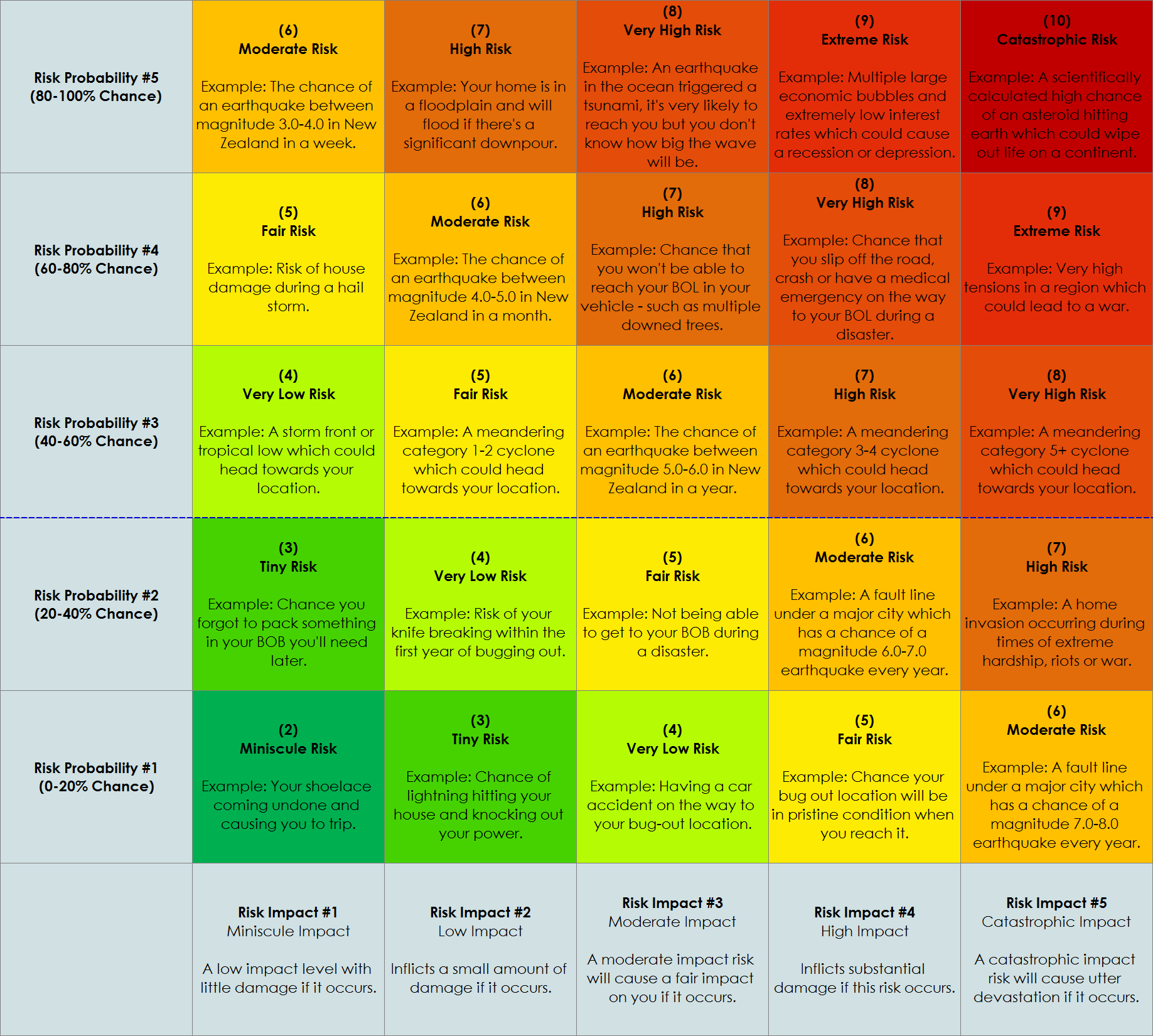This is an excerpt from my PDF ‘The Preparedness Encyclopedia (TPE)’.
Download the PDF Version Here
The sections below will help you identify, categorise and mitigate any risks that you may have relating to disasters or bugging in/out.
Managing Risks
The following is a guide on how you can gauge the approximate impact of any risks you may encounter.
1. Make a list of every risk that you can think of relating to your bug out plan. Use a list instead of a table, but if you want draw up a table to help visualise their severity.
2. Try to gauge the chance and the impact they will each have on your bug out plan.
3. Calculate the severity of each risk by adding the probability chance with the impact chance.
Probability No. + Impact No. = Severity
4. Order them by the calculated severity.
5. Work on a risk mitigation plan (explained further below) which will either reduce the severity or the chance of the risk. Work on the highest severity first.
Risk Impact
The below chart is a risk impact analysis of any risks you deem probable of occurring during a bug in/out.
● Risk Probability: The risk probability is the chance the risk has of occurring.
● Risk Impact: The risk impact is how much damage the risk will inflict if it occurs.
You first assign a probability of occurrence of the risk between 1-10 then determine the impact of the risk between 1-10 then find the risk impact from the chart. When you have the risk impact level you should take the necessary actions to mitigate or reduce the chance that rick occurs. It is not considered a risk if an event has a 0% or 100% chance of occurring. But the number range is there to cover all numbers such as 0.01% and 99.99% chances. If you create a table similar to the one below you can add as many vertical or horizontal cells as you like such as going up in 10%’s instead of 20%’s.
Risk Impact Table

Risk Mitigation
Ways to reduce the effects or the chance of the risk occurring. To mitigate risks you can either reduce the probability or impact of the risk or eliminate the risk completely.
● Risk Acceptance: Risk acceptance does not reduce any effects however it is still considered a strategy. This strategy is a common option when the cost of other risk management options such as avoidance or limitation may outweigh the cost of the risk itself.
● Risk Avoidance: Risk avoidance is the opposite of risk acceptance. It is the action that avoids any exposure to the risk whatsoever. It’s important to note that risk avoidance is usually the most expensive of all risk mitigation options.
● Risk Limitation: This strategy limits a company’s exposure by taking some action. It is a strategy employing a bit of risk acceptance along with a bit of risk avoidance or an average of both.
● Risk Transference: Risk transference is the involvement of handing risk off to a willing third party.
● Watch/Monitor: Monitor the environment for changes that affect the nature and/or the impact of the risk.
● Reduce Probability: Try to reduce the probability of a risk occurring. A simple example is tying your shoelaces if they are loose to help prevent you tripping. Another example is moving away from a fault line if you live near one.
● Reduce Impact: Reduce the impact of a risk by taking steps to prepare for more eventualities. For example you can install roller-shutters on every window of your house to help prevent damage from attacks, hurricanes and hail. You may get some dents, but it’s better than shattered windows.
● Eliminate Risk: If you have the ability to – you should eliminate risks entirely. For example if there’s a risk of not being able to reach your bug-out shelter due to flooding, perhaps you should live in your bug-out location permanently. If you’re concerned about tsunamis you should move at least 32km (20 mi) inland where it’s almost impossible for a regular sized tsunami to reach you.





